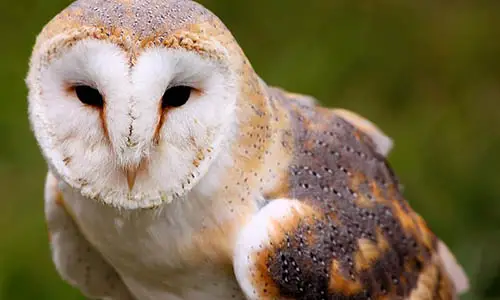There are 200 different owl species found all over the world, excepting Antarctica. Owls are nocturnal predatory birds. The have powerful talons that help them catch and kill their prey. Their prey consists of insects, small mammals, and other birds and in some species fish. They have very special necks that can turn the head as much as 2700. They are far sighted which means they have very sharp eyesight for things far away, but cannot clearly see things that are close by. Their feather colours which provide excellent camouflage and their silent flight make them successful hunters.
FACT 1: The barn owl lives mostly of cultivated land. It nests in old hawk nests, buildings, towers or in hollow trees.
FACT 2: The barn owl is sometimes called the monkey faced owl because of its heart shaped face. It also lacks the ear tufts common to other owls.
FACT 3: The barn owl hunts mostly mice and shrews and in the UK, field voles. They are specially adapted to hunt at night with super sensitive hearing and the ability to see movement in very little light. Their feathers are super soft. This enables silent flying. However their feathers are not waterproof, so the sight of a woebegone drenched owl is not uncommon.
FACT 4: Barn owls are 30 to 40 cm long. Their colour ranges from white grey to yellowish and brownish orange. Their eyes are smaller than other owls. Females are heavier than males. They weigh about 360 grams as compared to the male that weighs 330 grams. During breeding season the weight of the female increase to about 425 grams.
FACT 5: Female barn owls can be distinguished from males by the darker brown feathers around the facial disc. The females have black spots on the chest and the underside of the wings. They also have darker bars on the tail.
FACT 6: A group of owls together is called a Parliament. Barn owls screech, they do not hoot. They make an eerie shrieking and hissing sound.
FACT 7: Females lay about half a dozen eggs. Of these about 4 eggs will hatch. The owlets are born naked but soon sprout a soft down. This down is not enough to keep them warm, their mother continues to brood till they are about 3 weeks old.
FACT 8: While the mother is brooding, the father owl brings in small animal to feed the owlets. By three weeks the owlet can swallow a small mouse whole. When the owlets have enough feathers to maintain their body temperature, the mother owl helps the father with the hunting. Baby owls make their first flight at about 10 week and soon after start hunting their own food.
FACT 9: A barn owl has lop-sided ears. One is higher than the other. This helps them pin point exactly where the tiniest sound comes from. All these adaptations are necessary. The barn owl needs to be a proficient hunter. They require about four small mammals a night.
FACT 10: Before humans started to build barns for their cattle or crops, barn owls lived in rock crevices and hollow trees. People started to build haystacks and animal shelters about 5500 years ago. Barn owls became barn owls at this time. The Iron Age village in Glastonbury, Somerset, UK was discovered in 1892. Along with all the other archaeological treasures discovered, the bones of barn owls were found. Their bones are also found at the Roman Site in Cranborne Chase, Dorset.











Leave a Reply